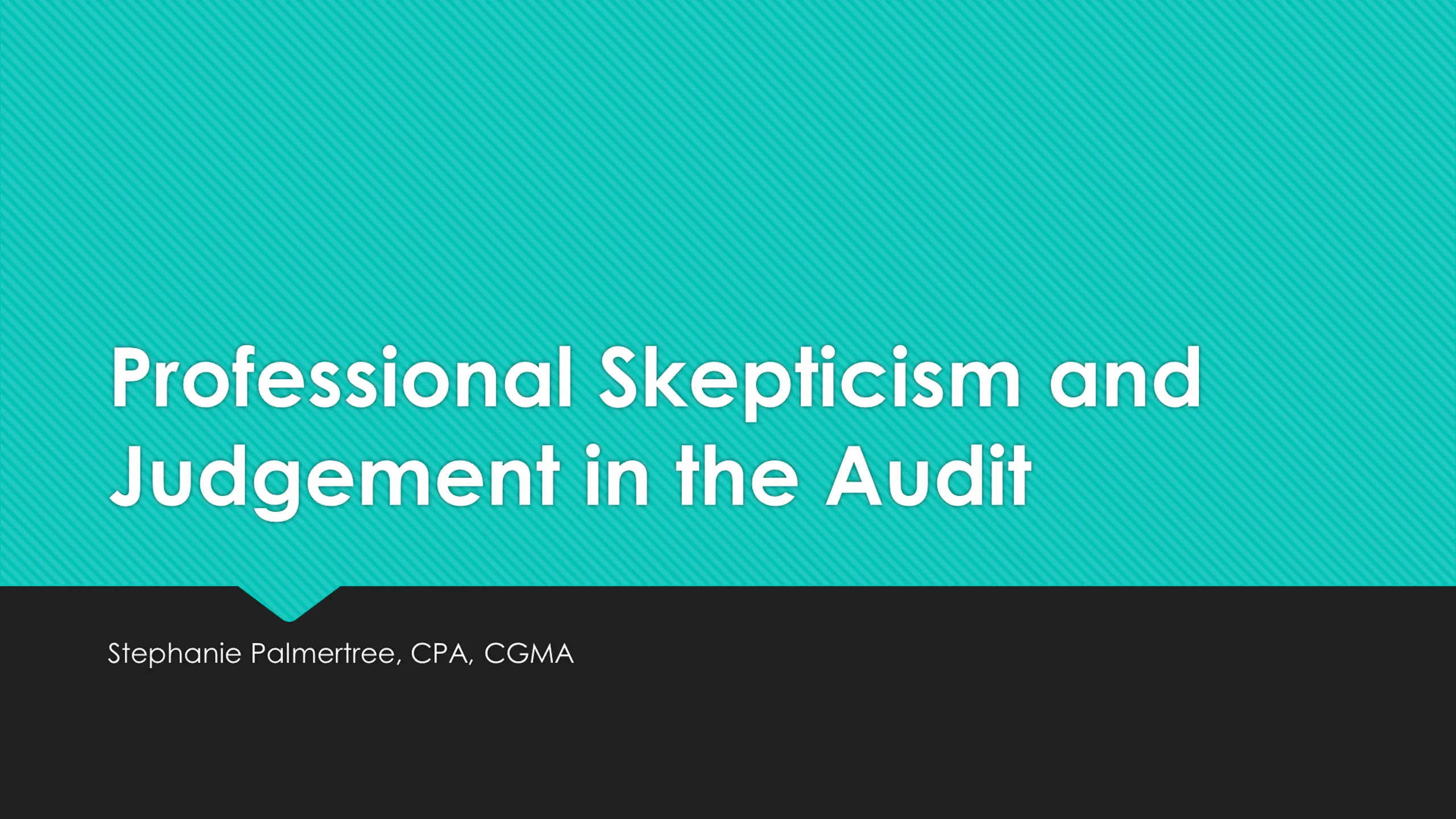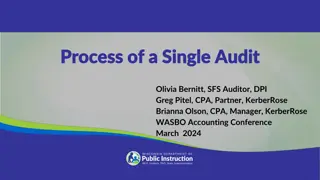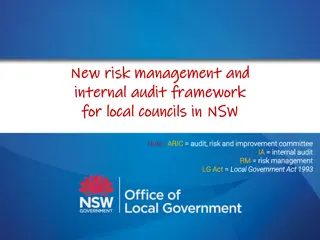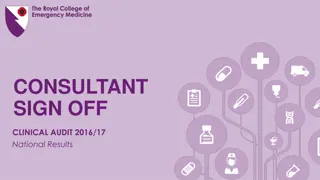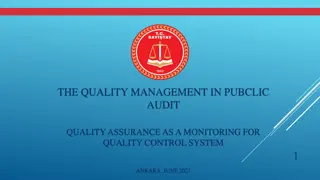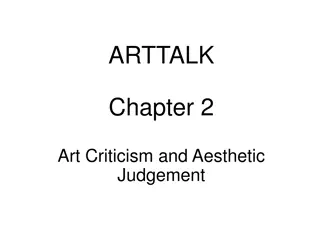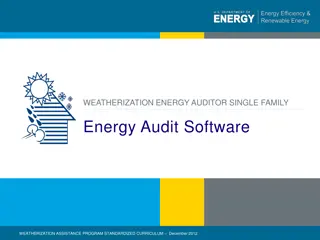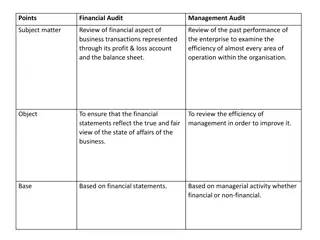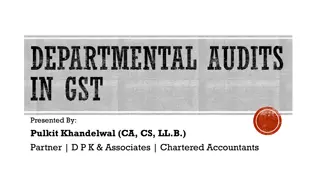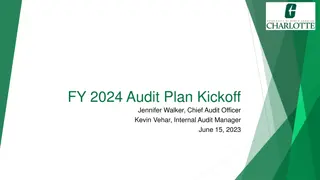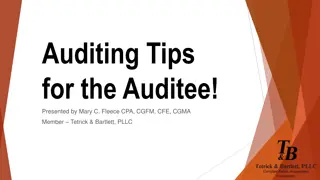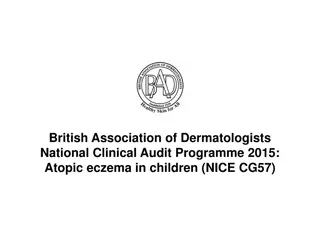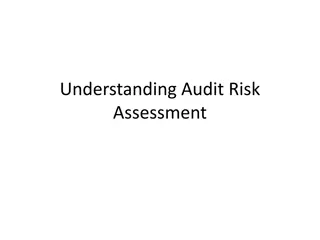Professional Skepticism and Judgement in the Audit
The importance of professional skepticism and judgment in the audit process. It covers topics such as critical assessment of evidence, audit evidence, due professional care, and the relationship between skepticism and due care.
Download Presentation

Please find below an Image/Link to download the presentation.
The content on the website is provided AS IS for your information and personal use only. It may not be sold, licensed, or shared on other websites without obtaining consent from the author.If you encounter any issues during the download, it is possible that the publisher has removed the file from their server.
You are allowed to download the files provided on this website for personal or commercial use, subject to the condition that they are used lawfully. All files are the property of their respective owners.
The content on the website is provided AS IS for your information and personal use only. It may not be sold, licensed, or shared on other websites without obtaining consent from the author.
E N D
Presentation Transcript
Professional Skepticism and Judgement in the Audit Stephanie Palmertree, CPA, CGMA
Professional Skepticism Professional skepticism is an attitude that includes a questioning mind, being alert to conditions which may indicate possible misstatement due to error or fraud, and a critical assessment of audit evidence. Critical Assessment - Judging the risk of bias, results and applicability of evidence
Audit Evidence (AU 326) Audit evidence is all the information used by the auditor in arriving at the conclusions on which the audit opinion is based and includes the information contained in the accounting records underlying the financial statements and other information. Auditors are not expected to examine all information that may exist. Audit evidence, which is cumulative in nature, includes audit evidence obtained from audit procedures performed during the course of the audit and may include audit evidence obtained from other sources, such as previous audits and a firm's quality control procedures for client acceptance and continuance.
Due Professional Care Calls for the application of the care and skill expected of a reasonably prudent and competent auditor in similar circumstances. Due professional care is exercised when audits are carried out in accordance with standards set for the profession.
How are Skepticism and Due Care Related Due professional care requires the auditor to exercise professional skepticism. Professional skepticism is an attitude that includes a questioning mind and a critical assessment of audit evidence. The auditor uses the knowledge, skill, and ability called for by the profession of public accounting to diligently perform, in good faith and with integrity, the gathering and objective evaluation of evidence.
Why is Professional Skepticism Important Professional skepticism plays a fundamentally important role in the audit, and forms an integral part of the auditor s skill set. It facilitates the appropriate exercise of professional judgment, particularly regarding decisions about: the nature, timing and extent of audit procedures to be performed to reduce the risk to an appropriate level; whether sufficient appropriate audit evidence has been obtained and whether more needs to be done to achieve the objectives of the relevant assurance standards; the evaluation of management s judgments (particularly regarding the application of the entity s applicable financial reporting framework in the context of an annual audit); the drawing of conclusions based on the audit evidence obtained.
Why is Professional Skepticism Important Gathering and objectively evaluating audit evidence requires the auditor to consider the competency and sufficiency of the evidence. Since evidence is gathered and evaluated throughout the audit, professional skepticism should be exercised throughout the audit process. The auditor neither assumes that management is dishonest nor assumes unquestioned honesty. In exercising professional skepticism, the auditor should not be satisfied with less than persuasive evidence because of a belief that management is honest.
Why is Professional Skepticism Important Professional skepticism is at the heart of what auditors do - Without it, the audit has little value. Professional skepticism is a foundation of the auditing profession that we need to maintain and evolve to support the audit of the future.
Three Elements of Professional Skepticism Attributes Mindset Action
Attributes Objectivity Mindset Action
Attributes Knowledge, Skill and overall ability of the auditor. The audit is to be performed by a person or persons having adequate technical training and proficiency as an auditor. AU 210.01 Auditors should be assigned to tasks and supervised commensurate with their level of knowledge, skill, and ability so that they can evaluate the audit evidence they are examining. AU 230.06. (knowledge, skills, and abilities of engagement team members should be commensurate with assessed risks).
Mindset The integrity and good faith of the auditor The auditor neither assumes that management is dishonest nor assumes unquestioned honesty. In exercising professional skepticism, the auditor should not be satisfied with less than persuasive evidence because of a belief that management is honest. AU 230.09. The auditor should conduct the engagement with a mindset that recognizes the possibility that a material misstatement due to fraud could be present, regardless of any past experience with the entity and regardless of the auditor's belief about management's honesty and integrity. AU 316.13.
Action Critical Assessment This element refers to the importance of performing a robust risk assessment, planning the engagement based on the risks involved, ensuring vigorous engagement supervision, and the diligent gathering and evaluation of audit evidence. Gathering and objectively evaluating audit evidence requires the auditor to consider the competency and sufficiency of the evidence. Since evidence is gathered and evaluated throughout the audit, professional skepticism should be exercised throughout the audit process. AU 230.08.
Risks to Proper Professional Skepticism Unconscious human biases and other circumstances can cause auditors to gather, evaluate, rationalize, and recall information in a way that is consistent with client preferences rather than the interests of external users. Scheduling and workload demands can cause pressures that might lead auditors to seek audit evidence that is easier to obtain rather than evidence that is more relevant and reliable; to obtain less evidence than is necessary; or to give undue weight to confirming evidence without adequately considering contrary evidence. Auditors may sometimes develop an inappropriate level of trust or confidence in management.
Risks to Proper Professional Skepticism Conditions inherent in the audit environment can create incentives and pressures that serve to inhibit professional skepticism. These pressures and incentives may include: avoiding significant conflicts with management; providing an unqualified audit opinion by a deadline; achieving high client satisfaction ratings; keeping audit costs low; building or maintaining a long-term audit engagement; Legislative pressures.
Six Characteristics of Professional Skepticism Questioning mindset a disposition to inquiry with some sense of doubt Suspension of judgment withholding judgment until appropriate evidence is obtained Search for knowledge a desire to investigate beyond the obvious, with a desire to corroborate Interpersonal understanding recognition that people s motivations and perceptions can lead them to provide biased or misleading information Autonomy the self-direction, moral independence, and conviction to decide for oneself, rather than accepting the claims of others Self-esteem the self-confidence to resist persuasion and to challenge assumptions or conclusions
Professional Skepticism and Analytical Procedures Analytical Procedures as substantive tests MUST have well developed expectations. Auditor must document those expectations, and any variances FROM those expectations. Analytical procedures should be designed to detect material misstatements; not support Management s Assertions
Documenting Professional Skepticism Document the thought process, alternative views considered, and changes to our approach in the course of the audit, not just the evidence supporting the final conclusion. Document how we challenged management views, assumptions, not just how we accepted them. Document the basis for unusual, one-time transactions and related business rationale. Include a complete and comprehensive record of discussions with management, particularly in areas of uncertainty. Document how we assessed the reliability of the source of documents, specifically those prepared by the entity. Document professional skepticism in the significant matters.
Hierarchy of Audit Evidence Third Party Evidence Evidence from documents Evidence obtained orally
Reliability of Evidence (AU 326.04) Audit evidence is more reliable when it is obtained from knowledgeable independent sources outside the entity. Audit evidence that is generated internally is more reliable when the related controls imposed by the entity are effective. Audit evidence obtained directly by the auditor (for example, observation of the application of a control) is more reliable than audit evidence obtained indirectly or by inference (for example, inquiry about the application of a control). Audit evidence is more reliable when it exists in documentary form, whether paper, electronic, or other medium (for example, a contemporaneously written record of a meeting is more reliable than a subsequent oral representation of the matters discussed). Audit evidence provided by original documents is more reliable than audit evidence provided by photocopies or facsimiles.
Professional Judgement The application of relevant training, knowledge and experience, within the context provided by auditing, accounting and ethical standards, in making informed decisions about the courses of action that are appropriate in the circumstances of the audit engagement. Professional judgement should never be used to justify decisions that are not supported by facts and circumstances of the engagement or sufficient appropriate audit evidence.
Five Elements to Professional Judgement Identify and define the issue; Gather the facts and information and identify the relevant literature; Perform the analysis and identify potential alternatives; Make the decision; Review and complete the documentation and rationale for the conclusion.
Five Elements to Professional Judgement Review and complete the documentation and rationale for the conclusion Gather the facts and information and identify the relevant literature Perform the analysis and identify potential alternatives Identify and define the issue Make the decision
Stages in the Audit Process Process for assessing & challenging the client s judgement Assessment of accounting and auditing guidance Knowledge gathering and analysis Documentation of judgement Principle 2In the context of the Principle 3After undertaking Principle 4If the auditing Principle 1Once all relevant applicable accounting framework, accounting and auditing standards, and other relevant guidance/literature appropriate due process to assess and challenge the client s judgement. judgement and the assessment and challenge of the client s judgement is suitably documented. and determinable information has been collected and analyzed.
Principle 1 Knowledge Gathering and Analysis Professional auditing judgement can only be made once all relevant and determinable information has been collected and analyzed. Read all relevant documentation, including contracts, agreements, correspondence, etc. Obtain additional information from elsewhere, as appropriate or necessary. Understand the client s process for determining the judgement, including an assessment of competence and review/approval processes in place and whether such procedures have been followed. Assess the risk of material misstatement in the financial statements. Understand/analyze the purpose, legal terms and economic substance of the transaction(s)
Principle 2 Assessment of Accounting and Auditing Guidance Professional auditing judgement can only be made in the context of the applicable accounting framework, accounting and auditing standards, and other relevant guidance/literature. Consider whether the transaction is covered by existing accounting standards, and the extent of judgement required. Identify and review other relevant accounting literature. Identify and review relevant auditing standards and guidance. Consider what would be the expected/common sense approach of accounting for the transaction. If any conflicts of interest or bias are identified, relating to the transaction, reference should be made to the relevant ethical guidance and standards
Principle 3 - Process for assessing and challenging The client s judgement Professional auditing judgement can only be made after undertaking appropriate due process to assess and challenge the client s judgement. Consider the uncertainties and range of possible outcomes of the transaction and compare with the client s assessment of these. Review the client s assessment of alternative treatments and the reasons for rejection. Evaluate whether significant assumptions made by the client are reasonable. Stand back and review the overall picture - consider the interaction with other judgements and the cumulative impact. Individual client judgements may appear reasonable in isolation but cumulatively may result in a higher risk of misstatement. Discuss with the client apply appropriate professional skepticism and challenge. Obtain appropriate advice from experts within the Agency or externally, where necessary. Identify any client conflicts of interest or bias to ensure the objectivity of judgements. If there are possible conflicts of interest or bias, reassess the above considerations with a greater degree of skepticism
Principle 4 Documentation of Judgement Professional auditing judgement can only be made if the auditing judgement and the assessment and challenge of the client s judgement is suitably documented. Documentation of significant matters arising during an audit, the conclusions reached thereon, and significant professional judgements made in reaching those conclusions. Record all key information reviewed, supporting evidence obtained and work performed. Include copies of relevant client schedules relating to significant judgements in the audit file. Ensure that there is also evidence of the audit assessment and challenge of those judgements.
Judgement Traps and Biases Overconfidence Bias Judgement Frames Availability of Data Anchoring and Adjustment Rush to Solve Confirmation tendency
Overconfidence Bias Overconfidence bias is a tendency to hold a false and misleading assessment of our skills, intellect, or talent. In short, it s an egotistical belief that we re better than we actually are. Overconfidence Can Lead To: Taking on too many projects Over promising on deadlines Considering only one alternative Truncating information search or even skipping evidence gathering Snap judgments Avoidance or poor execution of judgment model
Judgement Frames Framing bias is a type of cognitive bias where people were forced to decide based on the way the information is presented. Judgment frames are mental structures we use, usually subconsciously, to simplify, organize, and guide our understanding of a situation. Frames determine the information we see as relevant or irrelevant, important or unimportant Be aware you always have a frame! No single best frame, important to identify that frame and consider alternative frames Best example of framing Is the glass half full or half empty?
Anchoring and Adjustment We make assessments by starting from an initial value and adjusting away from that to form a final judgment. However, the adjustment from the anchor is typically insufficient. Auditors are particularly vulnerable to this bias since they typically begin their process with management-provided anchors (i.e., financial statements). Fixate on initial information and fail to adjust for subsequent information. Car Salesman/Carter s Jewelers
Availability of Data The availability bias occurs when individuals decisions are unduly influenced by information that is most memorable or easily accessible/ The tendency to consider information that is easily retrievable from memory as being more likely, more relevant, and more important for a judgment. Auditors may be tempted to easily consider the explanation provided by management, because it may be more challenging for them to generate additional possibilities.
Rush to Solve The rush-to-solve bias occurs when decision-makers form a judgment without fully considering all available data. This may occur if a management team reaches an early consensus without deliberating on an issue, or if auditors rely heavily on the perceived trustworthiness of a client when evaluating the likelihood of fraud. The rush-to-solve tendency may be exacerbated by external factors, such as time and budgetary pressures, and may inadvertently lead decision-makers to fall into other biases
Confirmation Bias Confirmation bias is the tendency for decision-makers to seek or interpret evidence in ways that support preexisting beliefs or expectations.
How to Reduce Bias Start with a clean slate Challenge the status quo Seek multiple perspectives Search for more information & data Play Devil s Advocate Reflect on your own views & values
